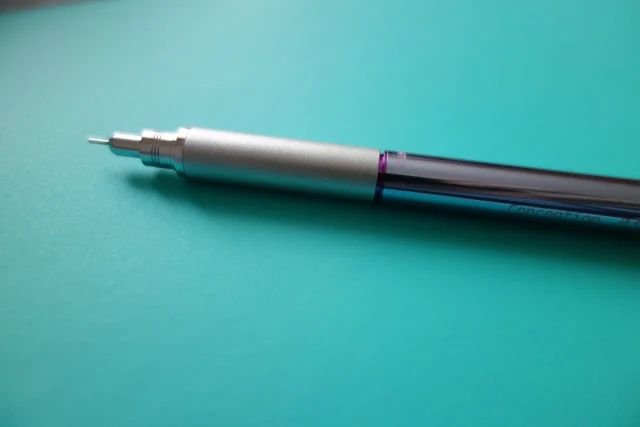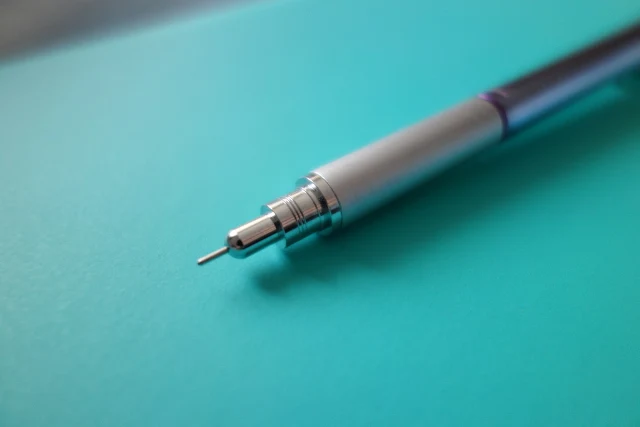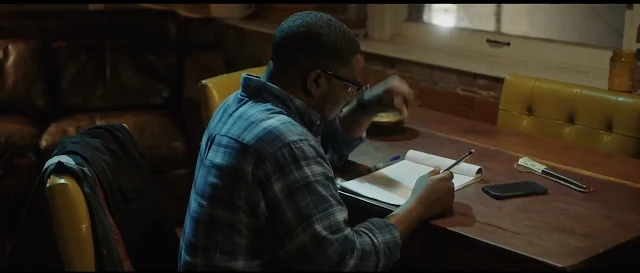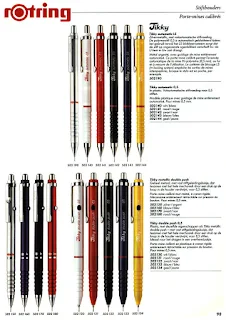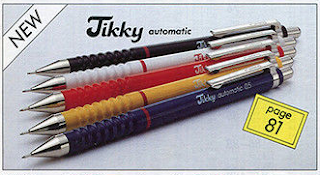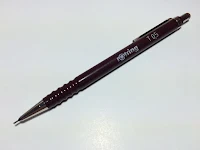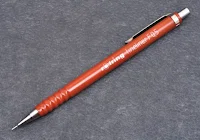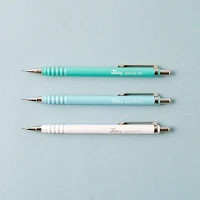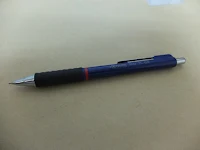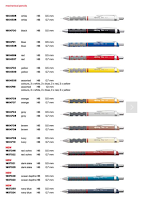Friday, September 6, 2019
Italic mechanical pencil
I guess it is very good for tests where you have to highlight the right answer, or when you pick the lottery numbers
I found this no name pencils on Aliexpress and I am wondering what are the applications for these leads. From what I found out Zebra has a similar mechanical pencil. And at some point in time, Faber Castell had a flat lead holder.
In the picture below with Faber Castell on the lead box (product number 9040), it is marketed as "Flat drawing leads"
Friday, June 7, 2019
Gutberlet manufacturer of mechanical pencils for Rotring and Staedtler?
Enter the Gutberlet site and you are welcomed by an outdated, plain looking site of an unknown manufacturer.
If you look at the products you are up for a treat
"Components for pens – technical components – decoration foils / heat-transfer-foils – packaging – OEM-production for pens."
"Push pencil aluminium with 0,3/0,5/0,7 und 0,9mm leads"
|
|
|
|
|
All of the images were taken from the Goultberg presentation portfolio link
Related post: kaweco OEM
Friday, February 8, 2019
KOH-I-NOOR 5340 5,6 mm lead holder
 So here it is, the Koh-I-Noor lead holder 5340 5,6 mm in gold. My initial impression was this thing is a lot bigger than I was expecting. I thought that it would be shorter. It kind of feels like holding a weapon. Big, bulky, all metal.
So here it is, the Koh-I-Noor lead holder 5340 5,6 mm in gold. My initial impression was this thing is a lot bigger than I was expecting. I thought that it would be shorter. It kind of feels like holding a weapon. Big, bulky, all metal.The design is simple and elegant, the mechanism inside is made out of brass, the outside is made out of aluminum and the barrel is painted goldish, while the rest of the parts are polished bare metal. The barrel is an octagon, and on a side, it is written in black KOH-I-NOOR HARDTMUTH. I guess this is not a subtle pencil so why would the writing on it bee any different.
Inside the mechanism's button, there is a sharpener for the lead. Also because of the thickness of the lead, you can use a regular pencil sharpener.
When you remove the cap, you have access to the lead inside, meaning you can fill or empty the pencil from the back, if the lead is not clamped in the clutch jaws.
The pencil was delivered with a lead, 2HB I think. It is plenty dark and smooth, so the writing experience is nice.
One of the bumps in the road is the consistency of the lead thickness. Some of the leads I bought along with the pencil are a bit too thick and they do not go in or out without persuasion. I have to pull on them or shake the pencil to force them out. And I can see little crumbles of graphite from the friction with the clutch.
After playing with the pencil for a few days I found it's role in my life. I think the designer of the pencil had artists in mind, but I do not draw. Or because of it's intimidating size it could be used for manly things. I read on a blog some time ago you can design a shed with it, and I think the one who did the review was pretty close to its purpose.
My use for it is "Visual Note Taking and Markings".
Thursday, December 27, 2018
Review of the Ohto Conception mechanical pencil
Excuses aside I want to review the Conception mechanical pencil which I have mentioned about in a previous post. Tanks to Matthias from Bleistift blog, Dave from Dave's mechanical pencils and
Brad from The Pen Addict.
This pencil was reviewed by Mathias from Bleistift.com some time ago, so please check his post and the youtube video.
I have seen them at that time but can’t remember the conclusion so this will be my view on the mechanical pencil. It will be interesting to see after, how each views the same product.
First of all the color, which I find it to be very nice. It could be seen as a bit feminine, but I think it works for everyone. It is an all metal body, with the barrel a light pale purple, a midsection with a darker violet. The grip is a mat finish gray that has a bit of tactile feel to it and it has enough grip. The rest of the pencil: tip, clip, and pusher are glossy gray.
The pencil has very subtle markings, OTO and Conception along with lead size, that is written in a color that is close to the barrel color and in a small font. It gives the pencil a clean look and technical feel.
This pencil has 2 very interesting features that make it a bit unique. The first thing that you notice are 4 holes in the side of the barrel that show you how much the lead advances. Yes, you can control it. So if you ever felt the traditional mechanical pencil doesn’t got this right you can opt for the Conception. At the maximum setting, the lead will advance 15 mm after 10 clicks and the minimum setting will offer 4 mm of lead for 10 clicks. A huge difference, and of course you can set it any ware between this 2 values.
The second unique feature of this mechanical pencil is the fact you can have a fixed sleeve or a retractable sleeve. By screwing the barrel to the grip you make it a fixed sleeve, that is very good for technical work, and precision lines. While for general writing you might prefer to have a sliding sleeve, so you will click the advance mechanism a lot fewer times. This makes the pencil pocket safe because the sleeve slides all the way in.
The clip and the eraser are good and I do not have complaints about them. One thing that is reminiscent of older pencils is a pointy tip imbedded in the eraser for unclogging the pencil. Rotring has dropped this after the first generation of Tikky, so I do know how to feel about it. Is the pencil not reliable enough and the manufacturer knows you will get into trouble? or is it there just to give you comfort and ease of mind in case something goes wrong? Take it the way you want, I am a bit skeptical.
One thing I have not talked about is the lead size. The pencil in my possession is a 0.3 m lead. It is the first one for me.
I don’t know how to feel about it at this moment, as I have not used it enough. Lately, I am incline to use 0.7 mm more often than the 0.5. I think this is because I rarely need the pencil to do detailed work and mostly I use it for notes. Engineer or not computers are used for the real work stuff while paper and pencils are mostly used to put down some thoughts, ideas and notes.
The fine point is a very different experience even compared to the 0.5 mm, and it offers a lot of control and precision. In the end this lead size to me seams to be a more specialized thing, making it less practical. I mean it is very good for detailed work and taking small notes in a limited space, for example, a book, but will not be very good for writing as you will frequently need to click the advance mechanism. Having a fine point makes it more fragile and having a sliding sleeve will make your lead break fewer times or not at all.
So in my opinion the purpose of the sliding sleeve in this pencil is more for protection, and not for long writing sessions.
The pencil offers a very nice feel in hand, for me is a great fit. One thing that I would change is the transition from the barrel to the grip section. It should have been better grinded to make a smoother transition.
One other thing I would like to mention is the screwing mechanism that makes the sleeve fixed or slide and the click of the lead advance. You can feel the spring that offers resistance and it is not smooth or quiet. It is not too bad, but I feel there is room for improvement.
Saturday, November 24, 2018
What lead size to use for general writing

I will start with, science is hard, or at least my pseudoscience is. I will test how the most common lead size perform:
0.5 / 0.7 / 0.9 or 1.0
0.9 and 1.0 is the same size, but different producers refer to it differently. From now on, I will refer to both sizes as 1.0
I guess you already have the answer to my question. Which ever lead size you like the most is the best, and I probably say 0.7 is the most usual lead of them all. But I am going further with my quest. So prepare ...
The so-called test
I wanted to see how much lead is used for the same amount of writing using each of the lead sizes mentioned above.
This is hard work, and I do not think I will be doing science anytime soon after all this experimenting.
I used Rotring HB leads with the aforementioned sizes 0.5; 0.7; 1.0. Other brands might offer different results because of the lead hardness "... 2B B HB H 2H ..." is not standardized. So HB from other suppliers might be softer or harder.
I started the test by writing 1-page size A4 (254x297 mm). To be as consistent as humanly possible, I used "math" paper and wrote in every single cell of the paper with very little pressure, and the same letter height, the letters of the alphabet over and over again. I preferred this method instead of freehand, so the results will be as scientific as correct as they can get.
This is not representative of real world writing, but it doesn't have to be. The important part of the test is comparing the leads to each other and see what are the differences.
After I wrote a few pages with each of the leads that are participating in the writing test, I measured the length of the remaining lead.
The results
In theory, I could have written with a single lead, size 0.5 mm, - 30 pages, but I have to take into account that when the lead becomes too small you have to throw it away, so more realistic I would say 27 pages.
Of course, this depends a lot on how small or big do you write, how condensed, how much pressure etc. So don't focus on this figure, as it is not the important one. The difference between the test results says the story.
The 0.7 mm can write in theory 60 pages and the 1.0 mm over 120 pages. This means that the writing you are able to do with 1 lead doubles every time you bump up the lead size.
Because I could not measure the lead used up on a single page with size 1.0 (under half of mm) I cranked up the pace and applied extra pressure and made a bunch of lines and X.
So after the endurance test the 0.5 mm lost 3.5 mm; the 0.7 mm lost 1.5 mm, and the 1.0 lost 0.5 mm from its total length
It does not seem a lot but assuming I could use the entire lead, 60 mm, the 1.0 size I could do as much writing as with 3 pieces of 0.7 mm lead or 7 pieces of 0.5 lead.
Similarly, if you would take the 0.7 mm as a benchmark, then I would need 2.33 pieces of 0.5 mm lead to do the same amount of writing.
Conclusion
You should choose the thicker lead, especially if you have a heavier hand, for three reasons.
1) The first reason is the price. The price of lead is usually the same for all thicknesses.
You will pay 3 times more if you use 0.7 lead instead of 1.0
You will pay 7 times more if you use 0.5 lead instead of 1.0
You will pay 2.33 times more if you use 0.5 lead instead of 0.7
2) The second reason is the advancing of the lead. The less lead you use, fewer clicks you will have to make. So in a long writing session, a thicker lead is bliss.
3) And third, the risk of breaking the lead is smaller with thicker lead.
Ok, you may ask, "Won't the line be too thick if I use 1.0 mm?"
It will, but not by a lot. There is a small difference between the 0.7 mm and the 1.0 mm lead. The downside is that you have to rotate the pen in your hand more often when you use 1.0 mm lead.
 |
| 1.0 mm vs 0.5 mm lead |
 |
| 1.0 mm vs 0.7 mm lead |
Friday, August 17, 2018
"Get Out" presents Bic Matic
The movie Get Out presents for a short period of time the famous Bic Matic
It's not the best movie, and I don't know if it deserves the mark it has on IMDB, but it has an interesting scenario.
In the movie, Rod is looking for his 26 year old friend, Chris. And to put down all his ideas, he uses a clear body Bic Matic with a yellow clip.
Also spotted in movies.
Thor using Bic four colours
Bic Matic Grip in cinema
Bic does not seem to be camera shy.
Thursday, August 2, 2018
Rotring 500 review
The 500 is the cheaper version of the 600, but it is not the cheapest in the line. Tthat spot is reserved for the 300 complete plastic build. The 500 is made in Japan and the build seems solid. The grip, lead hardness indicator, and the cap are made out of brass. The clip is made out of stainless steel and the barrel is plastic (ABS) but feels very nice to the touch.
Compared to the original 500 series, the modern version comes only in all black with the text and rings in red. The mechanical pencil has a dead serious look to it, it could be part of any minimalist EDC (if you carry it in a case as the tip is not retractable) or it can sit on an office desk. But the sleek look of the pen over the time will change, as the black color is painted rather than anodized. After heavy use, especially the grip section will show the white metal underneath.
Friday, May 11, 2018
Review Faber Castell Grip 1345 mechanical pencil
 |
| Faber Castell 1345 Grip II, 0.5 mm in blue |
There are 14 available barrel colors to pick from. The Faber Castell green, a traditional burgundy, dark blue, black and other very nice pastel colors.
I have, and will review the Faber Castell Grip II model, 1345 (that is 0.5 mm) color blue.
Because the pencil is made out of plastic, it is a light mechanical pencil, but it does feel good and solid in the hand.
Faber Castell has put thought into the pencils design. The barrel is made out of a glossy plastic. On the barrel, it is embossed with gold like paint GRIP 1345 0.5 the Faber-Castell logo and name.
After more wear and tear, I will say how the writing is holding up.
The top part of the barrel is brushed, so it has a matte finish to it. This makes the pencil more interesting and shows that someone has put thought about the design of the pencil.
The clip is metallic, elegant and feels secure.
The clicking mechanism holds a very long twist eraser. The plastic seems soft to the touch and has a chromed trim near the eraser. The advantage of this system is the long eraser, and the fact you twist to reveal it, so you do not risk losing the cap. The eraser has 3 cm of usable length, so it will last. Even this is a cool feature to have, and the implementation is nice I will not give it extra points, as I am one of those guys who don't like using the erasers on the mechanical pencils. Not because they are rubbish, but because I do not like the worn look, it makes the pen less appealing.
This way I enjoy a "brand new" pencil everyday.
The downside because of this long eraser is the feeling system. Because this eraser section is so long, it is harder to put the leads in.
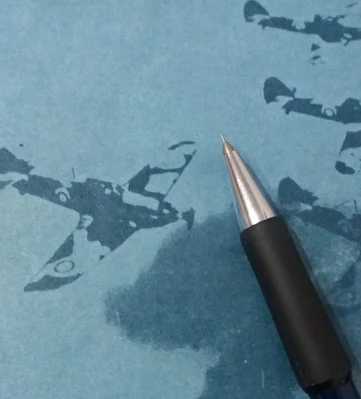 The tip of the mechanical pencil is conical and made from a chromed metal. It offers a retracting and sliding sleeve, so it makes for a pocket safe mechanical pencil. The retracting and sliding sleeve does not have a wobble to it, when you write it feels just a regular non-retractable sleeve.
The tip of the mechanical pencil is conical and made from a chromed metal. It offers a retracting and sliding sleeve, so it makes for a pocket safe mechanical pencil. The retracting and sliding sleeve does not have a wobble to it, when you write it feels just a regular non-retractable sleeve.Because of the conical tip, it's not a drafting pencil, it is intended for general use. The pencil comes with spring lead protection, meaning if you press harder on the lead, the lead will be cushioned by a spring. This works if you have a more vertical way of holding the pencil.
I like the way the sliding sleeve works (this is a feature also named "automatic" on some mechanical pencils). When the lead is used and the sleeve will hit the paper, and so it will slide back a little bit, revealing the lead. This means you can use the advance system less and the lead will be far less susceptible to break. But not all "automatic" pencils are created equal. Some of the problems this system encounters are: too much pressure to slide the sleeve, sleeves that do not have the right angle and not enough polish making them scratchy. I would give the Faber Castell Grip an 8.5/10 score for this feature. It works almost perfect.
The advance mechanism makes a nice clicky sound when pressed. The lead advancement is on the low side. 5 clicks will offer 3 mm of lead. In comparison, the Rotring Tikky (version 3) puts out 4.5 mm.
The grip section is made out of soft rubber. It is very comfortable and nicely integrated into the barrel, but I suspect it will have a relatively short life. It seems a bit soft, and it moves a bit under pressure, I think with time it will become looser. This is the drawback of the rubber grips. They are comfortable but not durable, and can be annoying to feel it move in hand. Other problems that might appear over time with rubber grips are: the hardening of the grip to the point it is uncomfortable, it cracks, or the rubber becomes sticky.
All this makes the Faber Castell Grip 1345 a very nice mechanical pencil, that I am happy to use as my daily writer.
Friday, February 2, 2018
Koh-I-Noor Versatil lead holder from 70s
A short history on the subject:
-In 1946 the introduction of metal mechanic pencils Versatil
-In 1957 the formation of the export subsidiary company Bohemia Works
The pencil I have is a Bohemia Works Toison D'Or Versatil 5900 made by Koh I Noor. There is nowhere the Koh I Noor name on the pencil. That is because the branding for exported products was Bohemia Works.
It is a 2 mm clutch lead holder, produced in the early 1970's. The pencil has an all metal body, painted black and a lighter color detail at the top. It has a hexagonal shape, the clutch system is brass and has a self sharpening system in the cap (unscrew the cap, and it has a 4 arm fork that sharpens the lead)
There were other models that featured a clip.
This pencil has seen a lot of action all these years. The writing on the side is gone, you can see where the writing was if you shine a light on the body. When it was new, it would have an embossed gold writing. The black paint is coming off in some parts and the barrel metal is showing. The detailing at the top part is mostly gone, showing the black paint beneath.
 |
| Koh I Noor Versatil 5900 70's design |
 |
| mechanism of Koh-I-Noor Versatil 5900 from 70's |
The last part is the cap of the advance system, which has a trident with which you can sharpen the lead (now it is a bident :) as one of the arms is broken). Even after all these years and use the pencil works as it should. One of the design flaws of the lead holder, in my opinion, is the smooth paint finish which tends to slip from your hand after a longer writing session.
If you are in the market for a pencil with a lot of history, this could be the one. You can buy vintage from eBay or new. Whatever pencil you will choose, it will be a "Versatil" one.
Looking at what Koh I Noor has to offer I found a very beautiful pencil with an old-modern design, knurled grip, the Koh-I-Noor notebook 5600. I will make a review of it shortly.
 |
| Koh I Noor notebook lead holder |
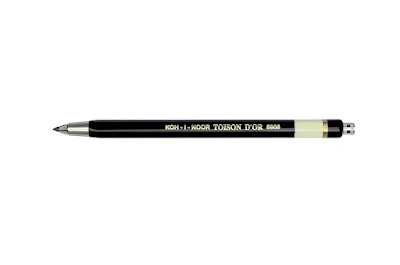 |
| Modern Koh I Noor Versatil |
Sunday, January 21, 2018
Rotring Tikky a short history
I am a long Rotring Tikky user and today I will share with you the beloved mechanical pencil.
I got my first Rotring mechanical pencil in middle school. If I am not mistaking it was a yellow second generation of Rotring Tikky. Unfortunately, I lost it sometime during high school. At some point, I had a red second generation Rotring Tikky but I can't remember it's faith. At the moment I have a black second generation Rotring Tikky 0.7 that I got in high school and used throughout the university, 2 Rotring Tikky's third generation one 0.5 and one 0.7 mm. One of my big regrets is that I do not have a Tikky Special first generation.
I only owned and used Rotring during the school years. The exception to this was my first mechanical pencil, a plastic no-name followed by a Bic. Both of them I had in the early years of school when I think my parents didn't trust me with a precision instrument :)
Both of my parents are engineers and both were using Rotring for many years as it was pretty much the standard in the industry. Why everyone was using them is pretty clear. They are affordable, of good quality, a precise instrument that will last a very long time, and they are readily available. They come in all sizes 0.35 mm, 0.5 mm, 0.7 mm, and 1.0 mm. And also, I do not think that the market back then didn't have such a plethora of mechanical pencils to choose from.
At least here (Romania), if you will go into a stationary shop it is almost certain they have Rotring Tikky mechanical pencils. In the last years, the Faber Castell has been a lot more aggressive and is starting to dominate the shelves of the stores. So maybe the new generations will grow with Faber Castell instead of the Tikky.
In the next lines, I will try sharing with you the information I have managed to gather about the Rotring Tikky mechanical pencils starting from the first generation up to the last.
The history behind the Rotring Tikky mechanical and the information about the models and their characteristics.
In 1979 the Rotring Tikky mechanical pencil debuts
In 1997 the second generation of Tikky hits the market
In 2008 the third generation of Tikky was available to the customers (still in production)
In 20024 the fourth generation the Tikky Retro tries to capture the memories with bold metallic colors
A nice graphical presentation of the Rotring history can be found on their site at the following link: http://www.rotring.com/en/heritage
Rotring Tikky
The first generation of Rotring Tikky was produced in West Germany and in Germany after 1989. It featured a metal drafting fixed point a slim body with a waved grip section. The barrel was made out of plastic or metal and it was available in different colors. It had a sturdy clip which was made out of metal and on it was stamped "Rotring" and "W. Germany" until 1989 and with "Rotring" and "Germany" after. The cap was metallic and was hiding the eraser. Only present in the Tikky Special, the eraser also had a pin in it to unclog the pencil if the lead would jam in it. The next models do not have this feature anymore. The mechanism inside was made out of brass and could be taken out of the pencil.Rotring came out with several models of the Tikky right at the beginning, and there were a few variants between labeling them. For example, not all Rotring Tikky first generation came with a red ring and others had the name rOtring written in red instead of the red ring. Some of the pencils featured an endcap that had on the tip of it standard color coding for the size of the lead. The barrel came in all sorts of colors, even crazy psychedelic paints.
With the first generation, Rotring seemed to use the size 0.3 mm and 0.9 mm instead of 0.35 mm and 1.0 mm nowadays.
Rotring introduced the Trio Pen which later became the Tikky 3 in 1. The first reference I found about the Trio pen was in a 1990 German product catalog but I think the model appeared sooner. Also alongside with the first Tikky mechanical pencil Rotring brought to the market the Tikky ballpoint.
The birth of one of the most beloved mechanical pencils took place 10 years before the launch of the Rotring 500/600 (1989) Series and 14 years before Rotring 800 (1993).
The Tikky I inspired Rotring to transfer the good features to the metal series 400 of mechanical pencils, pens, and fountain pens. This line was later marketed as Esprit.
The versions of the Tikky were:
Tikky Special
rotring T (sliding sleeve from 5 mm to 3.5 mm in early models, fixed sleeve later on)
rotring TS slide (half sliding sleeve - I think is the successor of the rotring T)
rotring Fineliner F or just rotring F (fixed 4 mm sleeve)
Tikky Automatic and rotring Automatic LS (auto advance of lead, LS stands for locking system)
Tikky Double Push (plastic and metallic versions - both these versions had a secondary push button on the barrel)
rotring S (plastic and metallic versions, 3 mm to 0 mm sliding sleeve)
The differences between the models:
Tikky Special - Plastic design with a fixed sleeve. It came in 0.3 mm, 0.5 mm, 0.7 mm. Some of the Tikky Special did not have a red ring while others had. There was a white version of the Tikky special which had all sizes available 0.3 mm 0.5 mm 0.7 mm 0.9 mm. The writing and the ring on these were color-coded to the lead size.
yellow for 0.3 mm
brown for 0.5 mm
blue for 0.7 mm
orange for 0.9 mm
rOtring T - "Mechanical pencil with fine lead T for technical drawings, before ink lining
Through the technical precision of the pencil rOtring T a long existing problem has been answered: making a neat drawing using a ruler and a template. The tubular lead guide retracts from 5 mm to 3.5 mm (the thickness of a ruler). rotring T is delivered in 3 lead sizes 0.3 mm, 0.5 mm, 0.7 mm, each model comes with HB polymer lead. The pencils container comes with 6 leads for backup."
The main feature of the T model is the partially retractable sleeve which was I think a safety mechanism for when using a ruler and also it gave the possibility to have maybe more control. The end cap had a size color coding.
The 1.5 mm retracting sleeve feature was abandoned as in the Rotring 1990 catalog the model rOtring T is marketed as a fixed sleeve.
rOtring TS slide - in the Rotring 1990 catalog, the rOtring TS slide is marketed as a half sliding sleeve. This I think is the successor of the model T which at this point became a fixed sleeve.
rOtring F - "Mechanical pencil with fine lead F for writing and sketching.
This pencil is equipped with a rigid tubular lead guide with a length of 4 mm which avoids lead brakes and offers a precision execution when using a ruler. rotring F is equipped with polymer lead size 0.5 mm HB. The pencils container comes with 3 leads for backup."
So the F model was available only in 0.5 mm.
Tikky Automatic LS - Metall mechanical pencil with fully automatic lead feed, comes in 0.5 mm. The lead automatically advances during use while the "LS" locking system prevents undesirable lead feed (when carrying in a pocket for example)
Tikky Automatic - Plastic version of the previous model, with fully automatic lead feed, comes in 0.5 mm. Does not feature the locking system. This model of the rOtring Tikky was first introduced in the 1988 Catalog
Tikky Double Push - Comes in a plastic and a metal version. It features a fixed sleeve protector and fully retractable feed mechanism. The main feature is a secondary side button to advance the lead. The metallic version of the double push sometime later changed series and became the Rotring 400 Esprit. Later the 400 was discarded and the line name remained Esprit. Rotring offered in the Esprit range fountain pen, ballpoint, mechanical pencil. The Esprit range offered a duo-pen (blue ballpoint and a 0.5 mechanical pencil in one body). There was a mini rotring Esprit line as well that included the mechanical pencil and the ballpoint. The Esprit mechanical pencil also came with a "telescopic" mechanism (available for the mini and the full version length)
The pencil was only available in 0.5 and 0.7 mm lead.
rOtring S - "Mechanical pencil with fine lead S for writing and neat sketching.
The tubular lead guide retracts with 3 mm in sync with the use of the lead. This way an optimal efficiency of the lead as well as a maximum safety against lead snaps. rotring S is equipped with polymer lead 0.5 mm, hardness HB. The pencil's container comes with 6 leads for backup."
So the S model features a 3 mm sliding sleeve. The body of the pencil comes in plastic or metal. The end cap had a size color coding.
The yellowish color is "safari green"
 |
| rOtring T / rOtring F / rOtring S (1980) Rotring product catalog (Romania) |
| |||
|
|
|
||||||
 Tikky Special Tikky Special |
||||||||
|
Metallic Double Push Tikky
|
|
||||||
|
|
||||||||
|
| |||||||
|
Tikky Automatic
|
rOtring Special without red ring
|
||||||
|
|
|
Rotring Tikky II
The Second Tikky suffered a few changes. First, it gained a little bit of weight. It became a little bit fatter. Second, the clip style changed. It is a less secure one, but aesthetically looks nice. The clip is not stamped with anything which is a shame. Where the clip meets the barrel it is cast in plastic with a very small font "Made in Germany". The rest of the writing on the pencil is paint. The barrel is plastic. The Tikky II weighs 10 grams.
The Rotring Tikky II was available in 2 major variants, the standard fixed sleved Tikky and the Tikky SC which had a sliding sleve.
rOtring Tikky II - which had markings on the pencil "rOtring Tikky II 0.5" or "rOtring T 0.5". This is the most common and wide spread version of the Tikky 2. It came in a variety of colors including metallic and transparent barrels.
The metallic colors were part of the INLINE series and offered options like pearl blue, pearl violet, pearl red, pearl yellow.
The rOtring Tikky II had versions of white and black color body which had the color coding on the side. Not all white and black Tikky's had the color coding though. The rest of the colors were not available with color coding.
rOtring T - basically it was the twin of the standard Tikky. But pencils with this branding were offered only in the burgundy body version and included ISO color coding in accordance to the ISO 3098, which allows at a glance to see what line width the pencil is. Except the different branding and the color coding the rOtring T was the same pencil as the rOtring Tikky.
Both the rOtring Tikky II and the rOtring T were available in 0.35 mm, 0.5 mm, 0.7 mm, 1,0mm. And were designed for"allowing you to make sketches, mechanical drawings and texts cleanly and accurately in accordance with drawing standards. The strong high-precision tip is ideal for use with a straight-edge and template. Making Tikky II a perfect tool for mechanical drawings and sketches."
rOtring Tikky SC - features a retractable tip and a rubberized grip. This one is less common and less accessible. The SC stands for Super Comfort. And it is presented as a "pencil with soft, non-skid grip area for even more relaxed writing. The rotring Tikky SC is perfect for people who spend a large amount of their time writing."
The pencil came in 4 colors, white, black, red and blue only with 0.5 and 0.7 mm widths.
(click on the images to enlarge)
rOtring Catalog 1999 Tikky SC |
Rotring Tikky III
The third generation named just Rotring Tikky is a reincarnation of the Tikky line after Rotring was bought by Standford. The pencil is also sold under the name "Papermate Tikky by Rotring" or just "Papermate Precision" version which does lack the traditional red ring.The third generation of Tikky debut in 2008 and is produced in China while the previous two were made in Germany. The biggest difference to the previous version is a partial rubberized grip (although the rOtring Tikky II SC featured a rubber grip, it had a different form), and the end of the barrel is triangular, making it less likely to roll off the table. The barrel is made out of ABS and the front cap is made out of stainless steel which has a constant slope as opposed to previous versions which had a step. The quality of this part I think is inferior compared to the quality found on Tikky II.
The clip style changed and now offers a look closer to the original Tikky clip, and it has stamped the rOtring name on it. The writing on the barrel changed to simply "rOtring Tikky 0.5", instead of numbering the generation with III. The cap has a hole at the top as a safety feature for children. It weighs 11.9 grams, 2 grams more than the second version and measures 142 mm in length from tip to cap and it has a diameter of 9 mm around the grip area.
Currently, the Rotring Tikky is offered in 23 colors, the latest colors included in the range are neon. Only the black and the burgundy models come with size color coding on the barrel and come in all lead sizes from 0.35 mm to 1.0 mm. They are marketed as Tikky professional mechanical pencils.
The classic Rotring colors like blue standard, white standard, yellow standard, red standard, black (version without the color coding) come in 0.5 mm, 0.7 mm, and 1.0 mm while the rest of the bunch come only in 0.5 or 0.7 mm.
(click on the images to enlarge)
Rotring Tikky Retro
The forth generation of Tikky has come to the market in 2024. The pencil is inspired from previous generations of rOtring with a set of features designed more for general writing. "The retractable tip prevents lead breakage, so every line you make is
sharp and clear. The rippled grip and lightweight barrel provide
exceptional comfort. Pencils are available in bold retro colors to
match your style". The pencil comes in two line widths 0.5 and 0.7 mm both of which are available in 3 colors metallic blue, metallic red and metallic grey. The size and weight of the Retro hasn't changed much from the Tikky III, diameter 9 mm, length 143 mm, and 139 mm with the tip retracted. Weight 12 grams.
Updates:
Nov 21, 2024 - Added the Rotring Retro, additional information about Tikky II, and pictures
Aprl 30, 2019 - Additional information about Tikky I, and Esprit
March 7, 2019 - Credits added
October 9, 2018 - Small updates, no extra information about Tikky line added
25/3/2018 - Tikky Automatic debut in 1998 (pic),
more information on Tikky Double Push metallic which became Rotring 400 Esprit, and then just Esprit (pictures)
Pictures of the pearl (metallic) Tikky II In Line added
Resources, extra information
Rotring catalogs
Rotring website
Pictures from sales site's like eBay and others alike
Particle Navigator
Mechanical Pencil Museum
Golyostoll (in Hungarian - if you need help google translate)
Pretty Splendid (beautiful Rotring Tikky 1 & 2 collection)
Kelvin Pang
A very nice history about Rotring products can be found at Unofficial Rotring
Contributions to the information presented are welcomed.
Popular Posts
-
This is the best and most fun game you can play, and you have to try it now. Why? Because it's hilarious, fast-paced, everyone in the...
-
I am a long Rotring Tikky user and today I will share with you the beloved mechanical pencil. I got my first Rotring mechanical penci...
-
Jinhao made me very curious with one of its latest fountain pen in the lineup. I had to have the pen just because of its nib. It is a bit un...
-
Rotring has moved away from fountain pens over the years. The only fountain pen model that is still available is the Rotring Artpen, whic...
-
Wing Sung 612 fountain pen Today I will share with you my very old Wing Sung 612 fountain pen, which is a Chinese Parker 51 look...












